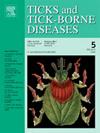瓜德罗普岛(加勒比地区)马螺形体病病原的遗传多样性:哈尼氏螺杆菌的首次报告、诊断工具的评估和马运动的影响
IF 3.4
2区 医学
Q2 INFECTIOUS DISEASES
引用次数: 0
摘要
马螺浆虫病是一种主要的蜱传马疾病,由螺浆虫(马感螺杆菌和巴贝斯虫)的细胞内发育引起,具有重大的经济和卫生后果。2024年,在瓜德罗普岛(加勒比)从无症状马身上采集了203份血液样本。采用针对马属寄生虫的18S rRNA巢式PCR (nPCR)检测,马伊勒菌阳性79份,卡巴贝斯虫阳性9份,阳性率分别为38.9%和4.4%。三匹马同时感染。对caballi的18S rRNA序列分析显示,caballi只存在A基因型。马弓形虫基因型A和C分别为单感染A(16/79, 20.3%)和单感染C(15/79, 19.0%)。有趣的是,马T. E基因型的单一感染(17/79,21.5%的感染马)也被检测到,但仅在从欧洲进口的马,特别是从法国大城市进口的马,这种基因型占主导地位。利用已发表的T. equi ma-1和T. haneyi特异性npcr进一步表征揭示了两个主要观点。首先,大多数18S rRNA基因型C分离株(13/15)采用哈尼伊t特异性nPCR检测。第二,这两种npcr均未检测到马氏弓形虫的E基因型。然后,利用18S rRNA测序、哈尼伊T.特异性nPCR和马T. -1 nPCR三种分析方法的组合来评估合并感染的发生和类型。同时感染基因型A和基因型C (T. haneyi)的马占主要群体(32/79,40.5%),而同时感染AE(5/79, 6.3%)和CE(2/79, 2.5%)的马较少。一匹马被检测出三重感染ACE。综合所有检测到的基因型(120株),45.0%为A基因型(54/120),38.3%为C T. haneyi基因型(46/120),16.7%为欧亚基因型E(20/120)。与E基因型合并感染的罕见性以及在当地出生的马身上不存在该基因型,表明E基因型没有通过当地存在的媒介蜱传播。这项工作代表了南、中美洲和加勒比地区的第一个哈尼氏菌分子记录。我们还演示了从欧洲引入马T.马基因型E,但没有安装,以及使用针对ema-1基因的PCR检测该基因型的诊断问题。本文章由计算机程序翻译,如有差异,请以英文原文为准。
Genetic diversity of equine piroplasmosis agents in Guadeloupe (Caribbeans): first report of Theileria haneyi, evaluation of diagnostic tools and impact of horse movement
Equine piroplasmosis is a major tick-borne horse disease, caused by the intracellular development of piroplasms (Theileria equi sensu lato and Babesia caballi), with significant economic and sanitary consequences. In 2024, 203 blood samples were collected in Guadeloupe (Caribbean) from asymptomatic horses. Using an 18S rRNA nested PCR (nPCR) specific for each equine genus parasite, 79 samples tested positive for Theileria equi and 9 for Babesia caballi, resulting in respective prevalence of 38.9% and 4.4%. Three horses were co-infected. For B. caballi, 18S rRNA sequence analysis revealed the presence of the genotype A only. For T. equi, the genotypes A and C were evidenced as mono-infections A (16/79, 20.3% of the infected horses) or mono-infections C (15/79, 19.0% of the infected horses). Interestingly, mono-infections with T. equi genotype E (17/79, 21.5% of the infected horses) were also detected, but only on horses imported from Europe and especially from metropolitan France, where this genotype is dominant. Further characterization using published T. equi ema-1 and T. haneyi specific nPCRs revealed two major points. First, most 18S rRNA genotype C isolates (13/15) were detected using the T. haneyi specific nPCR. Second, the genotype E of T. equi could not be detected by any of these two nPCRs. Co-infection occurrence and types were then evaluated using a combination of the three analyses: 18S rRNA sequencing, T. haneyi specific nPCR and T. equi ema-1 nPCR. Horses co-infected with the genotypes A and C (T. haneyi) represented the main population (32/79, 40.5% of the infected horses), while the co-infections AE (5/79, 6.3% of the horses) and CE (2/79, 2.5% of the horses) were rare. One horse was detected with a triple infection ACE. Taking into account all detected genotypes (120), 45.0% of the isolates belonged to the genotype A (54/120), 38.3% to the genotype C T. haneyi (46/120) and 16.7% to the Eurasian genotype E (20/120). The rarity of co-infections with the genotype E and the absence of this genotype on locally born horses suggest the absence of transmission of the genotype E by locally present vector ticks.
This work represents the first molecular record of Theileria haneyi in South and Central America and in the Caribbeans. We also demonstrate the introduction of T. equi genotype E from Europe with infected horses but not its installation, as well as a diagnostic issue to detect this genotype using PCR targeting ema-1 gene.
求助全文
通过发布文献求助,成功后即可免费获取论文全文。
去求助
来源期刊

Ticks and Tick-borne Diseases
INFECTIOUS DISEASES-MICROBIOLOGY
CiteScore
6.90
自引率
12.50%
发文量
185
审稿时长
6-12 weeks
期刊介绍:
Ticks and Tick-borne Diseases is an international, peer-reviewed scientific journal. It publishes original research papers, short communications, state-of-the-art mini-reviews, letters to the editor, clinical-case studies, announcements of pertinent international meetings, and editorials.
The journal covers a broad spectrum and brings together various disciplines, for example, zoology, microbiology, molecular biology, genetics, mathematical modelling, veterinary and human medicine. Multidisciplinary approaches and the use of conventional and novel methods/methodologies (in the field and in the laboratory) are crucial for deeper understanding of the natural processes and human behaviour/activities that result in human or animal diseases and in economic effects of ticks and tick-borne pathogens. Such understanding is essential for management of tick populations and tick-borne diseases in an effective and environmentally acceptable manner.
 求助内容:
求助内容: 应助结果提醒方式:
应助结果提醒方式:


